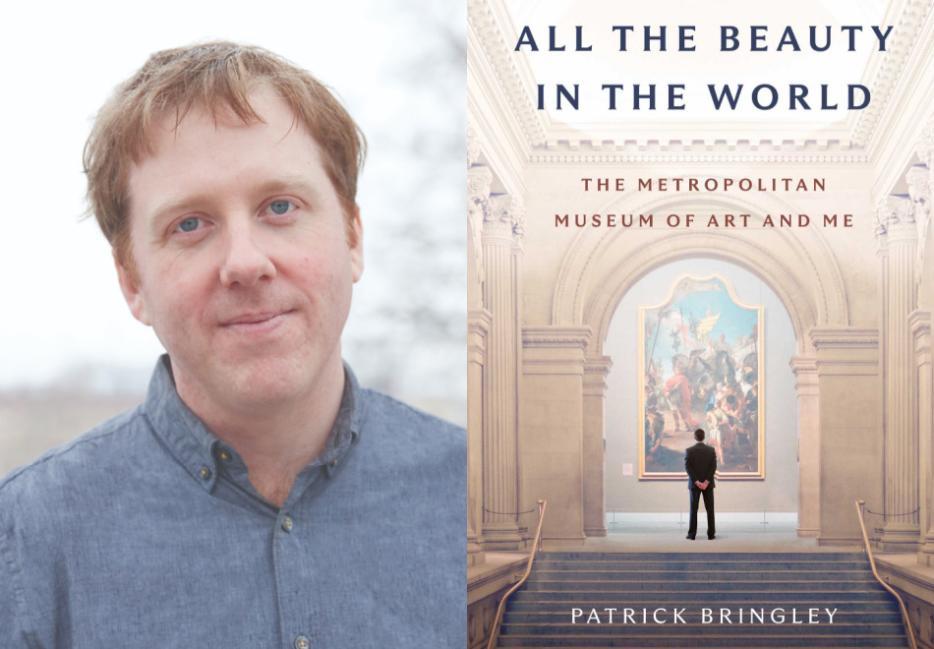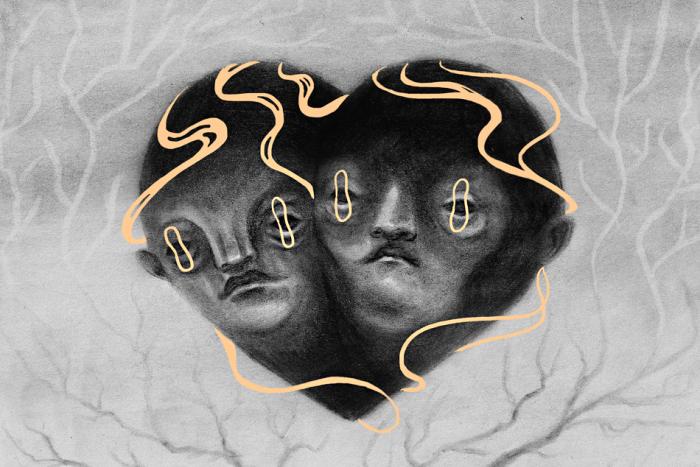No one would call it a glamorous job. In their identical modest dark blue suits and clip-on red ties, the guards of the Metropolitan Museum in New York are a bit like scarecrows, keeping order and keeping quite still. They’re on their feet for eight to twelve hours a day, often, punishingly, on marble floors. And yet they have as company some of the more precious, awe-inspiring objects in the world, with what must seem like endless hours to contemplate them.
The museum occupies five New York City blocks, an incredible encyclopedic storehouse spanning 5,000 years of culture from every part of the world: sculpture, vases, tapestries, photographs, furniture, musical instruments, armour, one Egyptian temple, and a surprising number of baseball cards. Plus some of the most instantly recognizable human gestures involving pigmented liquid—Monet’s spots, van Gogh’s swirls, Pollock’s sploshes and splats. The Met is New York’s most visited attraction, with around five million visitors a year.
As one of its guards, Patrick Bringley’s visit to the museum, you might say, lasted around ten years. In All the Beauty in the World (Simon & Schuster), he tells his personal story of a decade working at the Met, fulfilling the vital but somehow easily overlooked role of guard.
For Bringley, the job provided much-needed stillness when he was grieving the death of a family member. In between interactions with visitors, he attended the art on display.
More recently, Bringley has started leading tours of the museum. On a recent Saturday morning, he led a tour group into the less frequented visitors’ entrance on 81st and Fifth Avenue. “I never walk up those steps,” he said, referring to the palatial stone stairs leading to the museum’s more well-known front door. Leading the group on a winding path from Greek and Roman Art through Egyptian Art to Asian Art, he expressed a respectful awe for the museum and its collection. He also offered his own definition of art: “Something that is more beautiful than it had to be.”
It’s a definition that might well be applied to his book—a deeply felt memoir that serves not only as an intimate guide to the museum but to the experience of the essential human activity we call art.
I spoke with Bringley about the book, the museum, and his new line of work, which sees him wandering those familiar marble floors in a new capacity.
Darryn King: Patrick, you’re no longer working as a guard at the Met. But have you been back as a visitor? What’s that like?
Patrick Bringley: Yes! You know, I went and made the time to visit the Tudors exhibition, for instance. One thing that I definitely feel when I’m in there is, “Oh my god, I can’t believe that I’m just going to spend two hours in here.” My normal experience is being posted there for a day, and thinking this is cool, but knowing I’m going to have another five, ten, fifteen, or twenty days inside this gallery, sort of rattling around and absorbing things. I have to retrain myself to do things on a compressed time schedule.
The cliché question to ask guards in museums is, “What’s your favourite work of art here?” It’s either profound or banal. And of course, I’m sure different works of art speak to you at different times. But I do still want to ask you the question: What’s your favourite work of art in the museum?
It’s a difficult question to answer. I always feel that when you stand in front of a piece of art and commune with it, it’s somewhat hard, even when you’ve stepped away from it, a day or two later, to create exactly what was going on in that moment. You really only have that one moment. Your memory of it decays. So you have to return to the work.
But I can tell you about a picture I absolutely love. I adore Pieter Breugel’s “The Harvesters.” It’s a painting from around 1560. A lot of people consider it the first true landscape painting in the history of Western art. But, more to the point, it just feels expansive. It feels like a window. It’s one of these paintings that deepens the longer you look at it. The colours bloom. Thematically, the peasants huddling in the corner, taking a break from bringing the harvest in, enjoying a meal with each other, feels more universal and more sympathetic, and more human, against this grand unfurling landscape. It really feels like a painting that’s about a lot.
It’s an artwork that feels great, it’s not just that you find it, you know, aesthetically enchanting. It tries to get a lot, or something fundamental, across to the viewer.
Reading your book, it’s clear that guarding the Met’s galleries was a job you were in a unique position to appreciate, at a very specific time in your life. Tell me about your thought process when you signed up for it.
My brother had recently died. I found that the months spent at his hospital bedside, or at his apartment in Queens—it had a great simplicity to it. And a great straightforwardness of purpose. There was something very basic happening, which is that I was spending time with a loved one in a period of suffering. There was great tragedy about that, but there was also poignancy, and beauty, and substance.
The idea of just going back to any old office job and sitting at a desk and looking at screens and brown-nosing my boss and pleasing clients, or whatever—that felt too divorced from this glimpse of something greater that I felt I had just been participating in.
I relished the idea of going to a place where I could continue to keep my eyes on bigger things, keep my head clear, and think my own thoughts. And not need to engage in nonsense and office politics. I hit upon this idea of becoming a guard, both because it is a very straightforward and honest job, and because it offers this great, gigantic, nourishing meal of art to partake of.
What art spoke to you during that period?
When I first started as a guard my assigned home section was “Section B,” the Old Master paintings, and I was very grateful to be there. The paintings were gorgeous, obviously, but it was also the subject matter of the pictures, particularly the old, old pictures dating back to the 14th century. I’m not a Christian, but I was intensely moved by the depictions of Christ’s suffering and death. They were so sad, but so beautiful, and clearly the Old Masters were fascinated by that mix of emotions, by the poignancy of the human drama, its beauty and its pain.
There were paintings called “Adorations” and there were other paintings called “Lamentations” and sometimes I could hardly tell the difference between them, emotionally speaking. I understood that feeling. When you sit at the bedside of someone who is very ill, it’s very simple and bare and thus unbelievably beautiful, but it’s also anguishing. I appreciated remaining in that atmosphere and not having to just whiplash back to some office job.
It’s art from a time when part of the function of art was to help people make sense of their lives, provide instruction, even alter their beliefs. I wonder if you would have gotten quite as much out of doing this job at the Museum of Modern Art or the Whitney Museum, surrounded by more recent art.
When you look at art that was made a long time ago from different cultures, they’re very infrequently looked at as pieces of art history—as something that’s in conversation with other artists, or to be admired and appreciated for its aesthetic worth. Mostly, if you’re looking at an ancient Egyptian object, that object was made as a sort of machine with a definite spiritual purpose: to please some god, or to transition a person into a supernatural realm. Similarly, with an old altar piece, or something that was not made for people to nod their heads at and say, “Oh, isn’t that a great example of late-Gothic painting.” It’s primarily made for you to meditate upon the subject matter. Which is, oftentimes, something that has real import in how we think about the world and how we think about the human drama. That’s what they want foremost in our minds, usually.
I’m interested in the disparity between the guards’ and the curators’ experience of the museum. Of course, those folks, holed away in their offices, are contemplating art in a deep and thoughtful way. But your book reminds readers that the guards, unlike the curators, have these great long stretches of actual face time with the art. Do you think the guards get to experience something at the museum that the curators don’t? Apart from sore knees?
While on a post, you would often see the curators walk through, and they would walk through at a pretty fast clip. They were going to their office where they had something to do. They were writing an exhibition catalogue, or they were researching for a planned exhibition. I would certainly bob in their wake, as it were, and feel very privileged to simply—with no ulterior motive—experience the art.
I would sometimes feel that I was closer to the artists’ ideal viewer. These artworks, oftentimes, had been in a church, or they were in somebody’s home—meant to be experienced sort of passively. To seep into you over long periods of time. Rather than being studied with a definite purpose.
This isn’t to say that curators can’t put themselves in that frame of mind. But without question they have less opportunity to do so. They’re busy with other things.
I would also think to myself that I was very privileged as a guard to have complete freedom in my manner of thinking. If you’re a curator, you belong to a certain academic tradition. There are styles in which you tend to think, because that is how the field tends to think, or that’s how the museum has things framed. And that’s not to say that a curator can’t have original thoughts. Of course they can. But they can’t be so idiosyncratic as to decide, “You know what? Rembrandt stinks.”
I never thought to myself that Rembrandt stinks. But I could! I had total freedom to come up with my own idiosyncratic map of the Met and figure out what I responded to and didn’t respond to.
It’s clear in the book that, as well as enjoying looking at the art, you have a great love of people-watching in the museum, and interacting with visitors—even if it’s just to inform them that, no, there’s no Mona Lisa in the museum. Or dinosaurs.
I always appreciated the visitors who felt discombobulated. Those were the visitors who were most likely to talk to me. They see a guy wearing a suit that doesn’t look like a fancy suit—a little bit threadbare, a little bit cheap—you seem a sympathetic ear to them. And they ask you questions. I always thought they were right to feel all spun around in a museum that is enormous and tries to be about the whole wide world and beautiful things, cosmic things, intimate things. They saw me as a kindred spirit and they seemed to me as similarly wide-eyed. Sometimes, of course, I would turn up and it felt like a day of work. They would snap me back into the mindset of wanting to absorb all these things with a wide-open mind.
The visitors are funny, because they come at the art with all different styles of thinking and all different ways of being. I really valued the ability, through them, to escape my own narrow patterns of thinking; to realize that a work of art can be seen from many different angles, can be appreciated on different levels. It enriched my own thinking of what the Met is.
There’s a point in the book when you realize that coming to this astonishing place feels more like a job. Maybe that you’d outgrown the position. Can you describe that creeping realization?
I never felt that I outgrew the Met. To this day, I continue to visit, explore, and grow. But I do think that it’s natural, when you have a job, to start to focus on little things that annoy you about it. Or to come at it with a narrow mindset: oh, I can’t get the days off or overtime I want, or my feet hurt, or this guard who’s on my team today is not my favourite person. I think in some way, increasingly thinking along those lines was, paradoxically, a sign that I was doing a bit better. In my early days at the Met, I felt very speechless and quiet, and wide-eyed, and almost invisible, wanting to stand in the corner and take these things in. When I became a more veteran guard, I had fallen back into rhythm with the world; having friends at the Met, having opinions on the sections I liked and the sections I did not like. All these more normal things about feeling at home in your job. And part of feeling at home is sometimes taking it for granted, or complaining about little things.
How should people approach a visit to a museum like the Met?
I do think there are a fair amount of people who use it for its intended purpose. Which is, just show up, and explore, and get your head all turned around, and see some beautiful things, and press the palm of the person that you’re dating that you brought along with you, and have a beautiful and interesting afternoon. And then leave, hopefully carrying some lesson from it into the world that suddenly feels a little bigger or a little more full.
But I certainly do think, of course, that the Met could be used in a more full-hearted way. One thing I preach in my book: don’t think of it as a museum of art history, as a place to learn about art periods and styles. A lot of people are not particularly interested in that. Why should they be? There’s nothing that requires you to be interested in the history of early Renaissance painting or whatever the case may be.
But I would urge people to realize that the building is where you can learn not just about art but from it. Because really this art is about these very big and sometimes very intimate basic questions about life and death, and about the forces in the universe that we might call gods, and about the big mystery of existence, which is, in part: Why do we live in this world that is so colourful, and fragrant, and sensually rich, and beautiful?
You can go to the Met and see what civilization has made of those questions for thousands of years. And you can find things to agree with and things to disagree with; things to inspire you and things you can dismiss out of hand. You can have direct experience of these things.
What’s cool about the Met is it’s sort of like when you go on vacation in a foreign city and you stand in front of some beautiful landscape: “Man, I’m here. I am looking at the River Po,” or whatever the case may be. At the Met you have that sort of direct experience. You’re looking at the Rembrandt, it belongs to you, you are communing with it. It’s very real and it’s very direct. In that way, it’s sort of a contrast to looking at things on screens, for instance.
Lately you’ve been working as a tour guide in the museum. Getting to move from room to room must feel good! And an opportunity for you to share all the thoughts you’ve accumulated over the years.
It’s great fun. It’s fun having people in tow and, like you said, bringing them room to room and showing them things they might not otherwise see. Whereas as a guard you had to get a little bit lucky to find a person that might catch your eye and seem to be in the mood to be shown things and to talk about things.
I certainly draw on my experience as a guard, both in figuring out what I can say about these works of art or about these galleries that might be interesting to people. But also, in knowing how to relate to people and how to talk about art with people, and what they find interesting and inviting. As a guard I had thousands of casual conversations about paintings or sculptures with all sorts of different visitors who came into the museum, and I picked up the entry points that they found inviting into the art.
You’ve written a beautiful book about this job you had. But what would be your Glassdoor-style summary of the whole experience?
I think I’d analogize it to being a visitor in a great big art museum. In my first several years, I felt almost invisibly small as I wandered through a place that seems to pleasantly swallow you up. And then, as the years went on, I became interested in asserting myself and discovering what I think about these things. And discovering what use I could make of all this art. And also, this little world that I found around me within the Met, with all of its visitors and all of its guards. So the book tells my pathway from standing still, speechlessly, in the corner, to moving forward, exploring, and ultimately feeling like I had something to carry with me out of the museum altogether.






